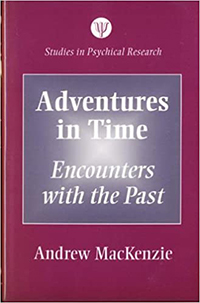Time Travel Stories
by James M Deem

Back to Main Time Travel Stories

Recommended Books
About Retrocognition
A different type of time travel experience happened in 1938, near the end of the Great Depression, when Marguerite Vassar was walking toward the pump outside her farmhouse near Milton, California. The farm had once been well kept, but it was rundown now that the depression had made it difficult for the Vassars to make ends meet.
That day in late spring, Marguerite was alone.  Her husband had gone to work, her children were in school. Since there was no indoor plumbing, she had gone outside, heading for the pump. She had just turned the corner of the house when she suddenly felt different. Later, she said that she had been "caught up in time."
Her husband had gone to work, her children were in school. Since there was no indoor plumbing, she had gone outside, heading for the pump. She had just turned the corner of the house when she suddenly felt different. Later, she said that she had been "caught up in time."
As she stood there, aware of some time change, a woman burst out of the farmhouse door, a terrified look on her face. She must have been baking, because Marguerite noticed that her hands were covered with flour. Then Marguerite detected the smell of fresh bread and cut strawberries wafting from the kitchen. Like most other people who see an unexpected and unusual scene from the past, Marguerite didn't question what was happening. She didn't wonder how the woman had gotten into her house, or where the odor of bread had materialized from. She simply observed as the scene unfolded, as if she were watching a play.
Marguerite heard footsteps running up the path that connected the farmhouse to a nearby pond. She turned and saw two young boys rush toward the woman. When they reached her, they buried themselves in her skirt. Further behind were three men. One was carrying pitchforks, but the two others carried the lifeless body of a teenage girl. She had long blond hair, but it, like the rest of her, was soaking wet.
One of the boys ran to open the farmhouse door. The woman ran in, followed by the men. As the story goes, Marguerite supposedly stepped in behind them before the door closed.
What she saw was a kitchen, but not the one she had become used to. A pot of stew was bubbling on the stove. A red-checked cloth covered the table. In the center were fresh strawberries in a blue bowl. Fresh bread was cooling on the counter. But no one was there.
She noticed a trail of water on the floor and followed it through the kitchen and living room to a bedroom. As Marguerite reached the door, she watched the woman pulling the top covers from bed. Then men laid the girl's body down. boys looked scared, the adults were crying.
At that moment, Marguerite's vision of the past faded. Only she wasn't in the house, she was where she had been standing at the corner of the house. She ran inside, but found no trace of the stew or bread or strawberries--or of the drowned girl.
She told her husband about her experience that night, but he had no explanation for it and thought nothing about it. That is, until a few weeks later when he brought a homeless man to the house for dinner and a place to spend the night. The man's name was Vencil and over dinner he told Marguerite and her husband that he had once lived on the farm, when it belonged to his brother.
His sister-in-law was a deeply religious woman who did not believe in working on Sunday. Her husband always respected her beliefs until one Sunday during the summer of 1904 or 1905 when the hay crop had to be harvested before it spoiled. Although she asked her husband not to harvest the rest of the hay until Monday, he convinced her that he had no choice. Rather than let her husband work alone, she decided to complete a number of chores. She sent her boys strawberry-picking and her daughter swimming in the pond.
Marguerite was not surprised to hear that the daughter had drowned that afternoon. Her body was recovered from the pond with pitchforks and carried into the house.
The following Sunday, according to Vencil, no one worked. The mother hitched the buggy and took her boys and her year-old baby to church. But as they drove down the dusty road and up a hill overlooking the pond, the horses became spooked and reared. The buggy turned over, injuring one of her sons and killing the baby. From then on, Vencil said, tragedy followed the family. Eventually, they sold the farm and moved away.
Had Marguerite Vassar had a vision of a tragedy in a past time?
Author Gracia Fay Ellwood wanted to know. She attempted to contact Mrs. Vassar, but was unable to do so. She then wrote to cemeteries in the Milton area to see if anyone named Vencil had been buried there, especially two children in 1904 or 1905. Old cemetery records, however, are often incomplete and Mrs. Ellwood was unsuccessful. Still, she did find a family plot for a "Vanciel" family, which contained three graves.
None were for children, but it is possible that Marguerite Vassar was uncertain how to spell the family's name, especially if she only heard it spoken and hadn't seen it in print.
Again, the problem of proving that a retrocognitive experience really happened is one that will never go away. Mrs. Vassar had an unusual retrocognitive experience--if she is to be believed.
What do you think?

Copyright © James M. Deem. Adapted from How to Travel Through Time (New York: Avon, 1993). All rights reserved.

